Delaware, a jewel of the Mid-Atlantic region, is not just known for its picturesque landscapes and scenic beaches, but also as a haven for bird watchers. The state’s diverse habitats are home to a variety of bird species, including a collection of blue birds that add a splash of color to its rich tapestry of wildlife.
This guide is dedicated to the 12 spectacular blue birds in Delaware, from the vibrant Eastern Bluebird to the striking Blue Jay. Whether you’re a seasoned birder or a beginner looking to learn, this guide, complete with a FREE photo guide, will help you identify and appreciate the blue birds that call Delaware home.
Blue Birds Found In Delaware
The geographical diversity of Delaware, although limited in extent, plays a significant role in making it an attractive habitat for a variety of bird species. The coastal plain, along with its marshes and wetlands, provides essential breeding grounds for many waterfowl and shorebirds. The deciduous forests, on the other hand, provide nesting sites and food for a variety of songbirds and raptors.
This diverse range of habitats, combined with its location along the Atlantic Flyway – a major migratory route – contributes to the wide variety of bird species found in the state, including a number of blue bird species that add a dash of color to the Delaware landscape.
Eastern Bluebird
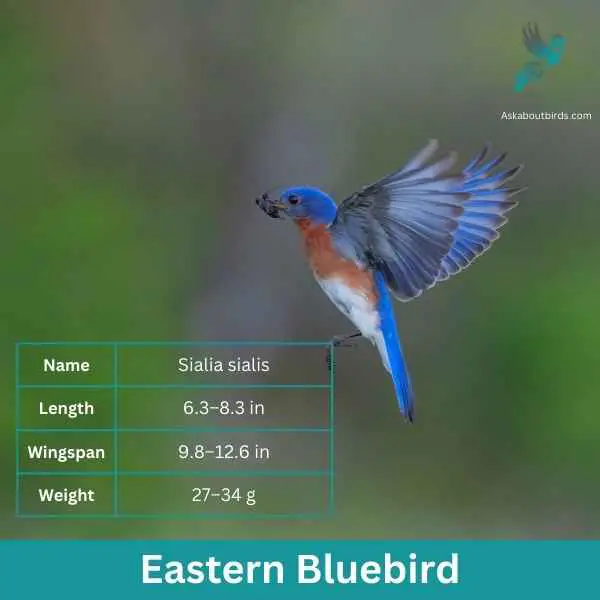
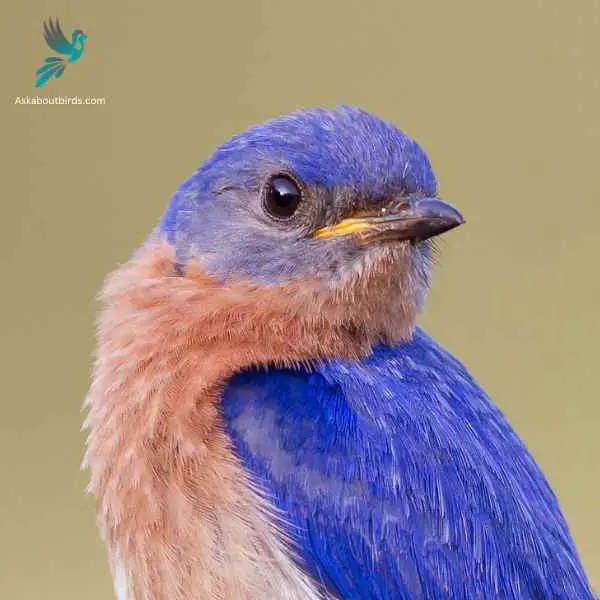
| Feature | Measurement |
|---|---|
| Scientific Name | Sialia sialis |
| Length | 6.3–8.3 in |
| Wingspan | 9.8–12.6 in |
| Weight | 27–34 g |
The Eastern Bluebird (Sialia sialis) is a small thrush found in open woodlands, farmlands, and orchards, and is recognized for its vibrant blue and red coloration. Male Eastern Bluebirds are dazzling with bright blue upperparts and a rusty or brick-red throat and breast, while females, though less colorful, still offer a similar pattern. The bird is native to North America and is commonly seen east of the Rockies, from Canada to the Gulf States and southeastern Arizona to Nicaragua.
Eastern Bluebirds feed on insects, wild fruit and berries. They have a gentle nature and are often seen perched alone or in small groups in the open, scanning the ground for prey. They are cavity nesters and will use old woodpecker holes or birdhouses if they are the right size.
Blue Jay
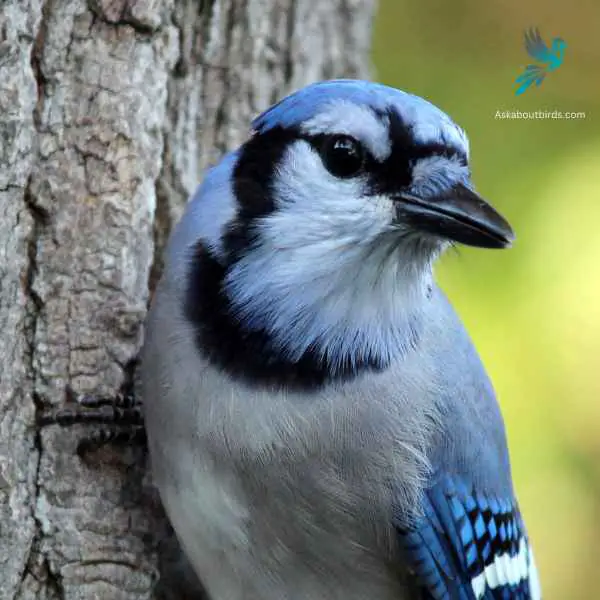
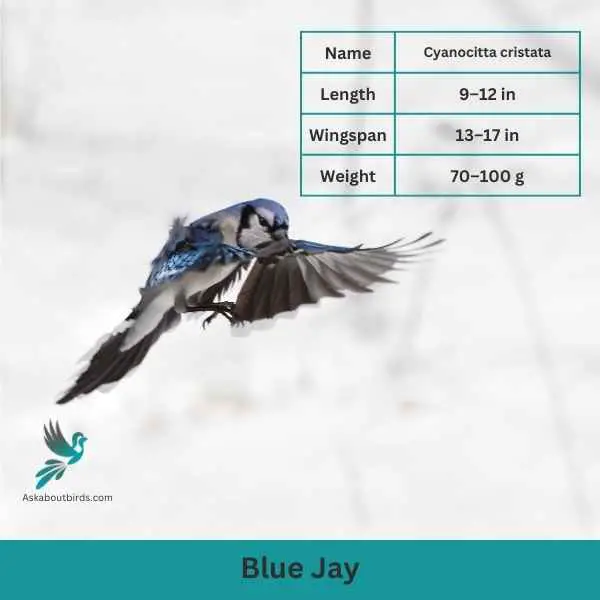
| Feature | Measurement |
|---|---|
| Scientific Name | Cyanocitta cristata |
| Length | 9–12 in |
| Wingspan | 13–17 in |
| Weight | 70–100 g |
The Blue Jay is a vibrant and easily recognized bird, known for its intelligence, distinctive calls, and bold behavior, commonly found throughout the eastern and central United States.
Appearance: The Blue Jay sports a striking blue upper body with white and black markings. Its face has a pronounced white patch with a black necklace that runs across the throat and around the head. The bird also features a pronounced blue crest, which can be raised or lowered, and its wings and tail are brightly colored with black bars and white tips.
Diet: Blue Jays are omnivores. Their diet consists primarily of seeds, nuts, especially acorns, fruits, and small insects. They’ve also been known to eat eggs or nestlings of other birds occasionally. Blue Jays often store food items in caches to eat later.
Reproduction: Blue Jays are monogamous birds that form long-lasting pair bonds. They typically build their nests in trees or large shrubs, constructing them from twigs, grass, and sometimes using mud as a binder. The female lays a clutch of 3 to 6 eggs, which are pale blue or sometimes white with brown speckles.
Indigo Bunting


| Feature | Measurement |
|---|---|
| Scientific Name | Passerina cyanea |
| Length | 4.5–5.1 in |
| Wingspan | 7.1–9.1 in |
| Weight | 11.2–21.4 g |
The Indigo Bunting is a strikingly vibrant songbird, often hailed for its brilliant blue plumage and melodic song that graces woodlands and meadows during the warmer months.
Appearance: Males are renowned for their bright indigo blue feathers, which can appear darker in certain lights. Females and juveniles, on the other hand, are brown with subtle hints of blue on their wings and tail. The species lacks the vibrant streaking or spotting commonly found in many other songbirds.
Diet: Indigo Buntings primarily subsist on seeds, especially during non-breeding seasons. During the breeding season, they also consume a variety of insects such as beetles, caterpillars, and spiders, providing essential protein for their growing chicks.
Reproduction: Indigo Buntings build their nests close to the ground in shrubs or low tree branches. These nests, crafted meticulously with grasses and other plant materials, cradle clutches of typically 3 to 4 eggs. After hatching, the young are fed by both parents until they’re ready to fledge.
Tree Swallow
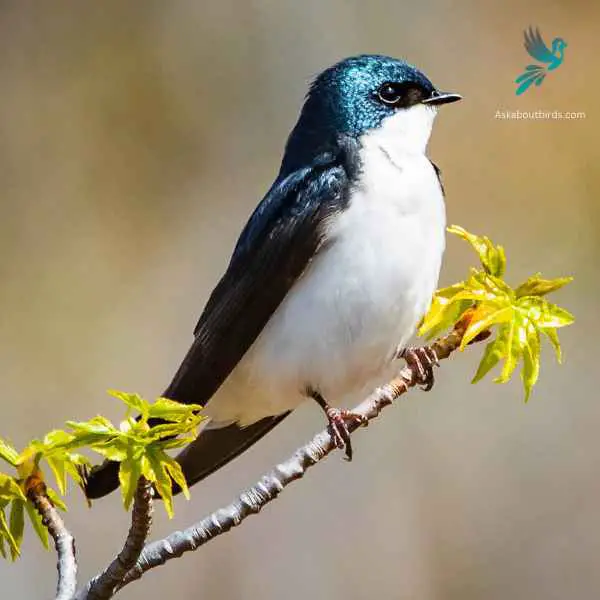
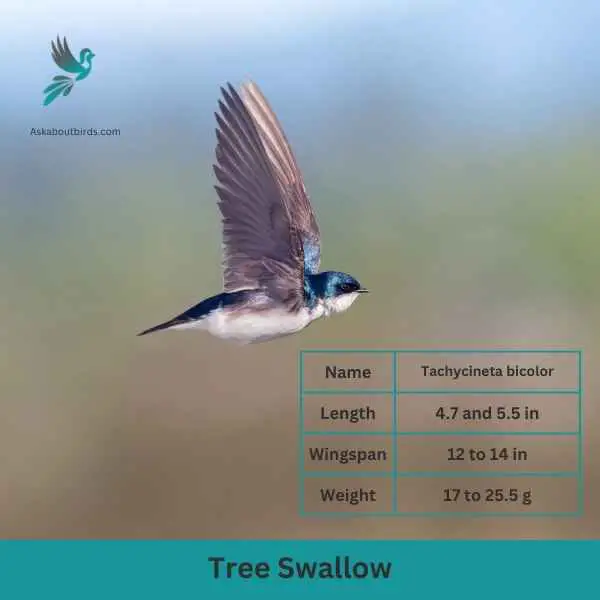
| Feature | Measurement |
|---|---|
| Scientific Name | Tachycineta bicolor |
| Length | 4.7 and 5.5 in |
| Wingspan | 12 to 14 in |
| Weight | 17 to 25.5 g |
The Tree Swallow is a graceful and agile bird, best recognized for its iridescent blue-green upperparts and sweeping flight patterns over open fields and water.
Appearance: The Tree Swallow is sleek with a streamlined body. The upperparts shine with a blue-green iridescence while the underparts are white. They possess long, pointed wings and a slightly forked tail, aiding in their agile flight.
Diet: Tree Swallows primarily feed on flying insects, skillfully catching them mid-air. During colder months when insects are scarce, they can switch to a diet of berries, particularly those of the bayberry, which other birds might find hard to digest.
Reproduction: Tree Swallows are cavity-nesters, typically choosing natural holes in trees or using bird boxes. They line their nests with feathers, creating a soft environment for the eggs. The female will lay a clutch of 4 to 7 white eggs.
Barn Swallow
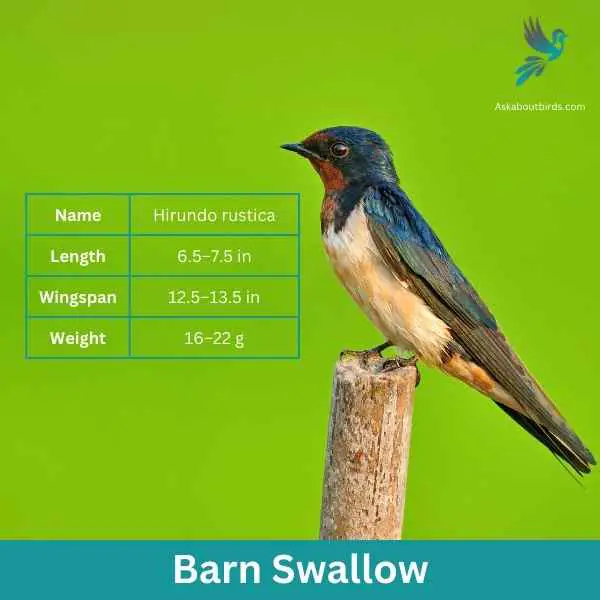

| Feature | Measurement |
|---|---|
| Scientific Name | Hirundo rustica |
| Length | 6.5–7.5 in |
| Wingspan | 12.5–13.5 in |
| Weight | 16–22 g |
The Barn Swallow is a sleek, agile bird renowned for its graceful flight patterns and iconic forked tail, often seen darting over fields and water bodies in search of flying insects.
Appearance: Barn Swallows have deep blue, almost iridescent, upperparts and a rufous to tawny underbelly. Their distinctively forked tail and long wings give them a streamlined look. Both males and females have a similar appearance, though males often exhibit slightly brighter colors and a deeper fork in the tail.
Diet: Barn Swallows feed primarily on flying insects, which they catch in mid-air during their agile and acrobatic flights. Their diet includes flies, beetles, moths, and other small flying insects.
Reproduction: Barn Swallows are known for building their mud nests on man-made structures, particularly barns, bridges, and eaves. The nest is cup-shaped and made from mud pellets, often lined with feathers. The female lays a clutch of 4 to 6 eggs.
Purple Martin
| Scientific Name | Length | Wingspan | Weight |
|---|---|---|---|
| Progne subis | 7.5-8.7 in | 15.3-16.1 in | 1.6-2.1 oz |
The Purple Martin is the largest North American swallow known for its acrobatic flight and sociable behavior.
Appearance: Adult male Purple Martins have iridescent, dark blue-purple plumage overall, while females and young have a duller, grayish-brown upperparts and white underparts with a grayish chest. The wings and tail are blackish.
Diet: Purple Martins feed almost exclusively on flying insects, including dragonflies, damselflies, flies, beetles, wasps, and moths. They catch their prey in the air, often flying high and covering large distances in search of food.
Reproduction: Purple Martins are cavity-nesting birds and have come to rely on human-provided nesting structures in the eastern parts of their range. The female lays a clutch of 3 to 6 eggs, and incubates them for about 15 to 18 days. Both parents feed the young and defend the nest.
Belted Kingfisher

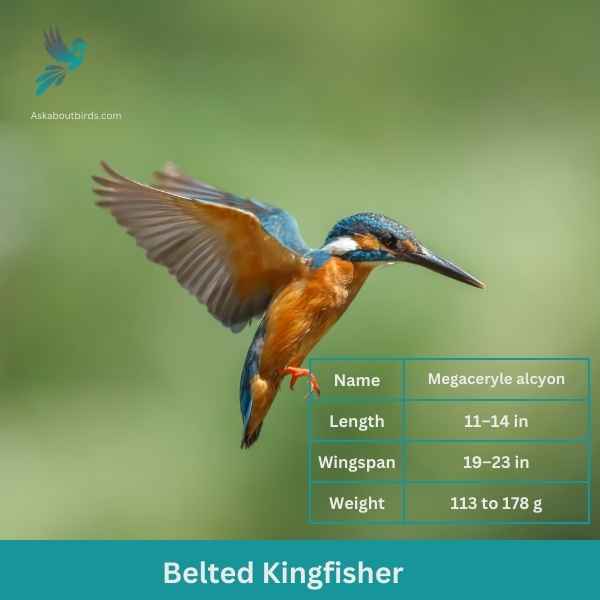
| Feature | Measurement |
|---|---|
| Scientific Name | Megaceryle alcyon |
| Length | 11–14 in |
| Wingspan | 19–23 in |
| Weight | 113 to 178 g |
The Belted Kingfisher is a distinctive and easily recognizable bird, frequently observed near water bodies, where it can be seen diving headfirst to catch prey.
Appearance: Sporting a prominent crest, the Belted Kingfisher has a slate blue-gray upper body and white underparts. Males possess a single blue band across their white chests, while females have an additional rufous band, making them one of the few bird species where females are more brightly colored than males. Their bill is long, sharp, and dagger-like.
Diet: As expert fishers, Belted Kingfishers mainly prey on small fish, but they’ll also consume crustaceans, insects, and amphibians. They’re known for their hunting tactic of hovering over water, spotting their prey, and then diving swiftly to snatch it.
Reproduction: Belted Kingfishers nest in burrows which they excavate in sandy or earthen banks, usually adjacent to water. The tunnel can be anywhere from 3 to 6 feet long, ending in a chamber. Within this chamber, the female lays a clutch of 5 to 8 white eggs.
Blue-winged Warbler
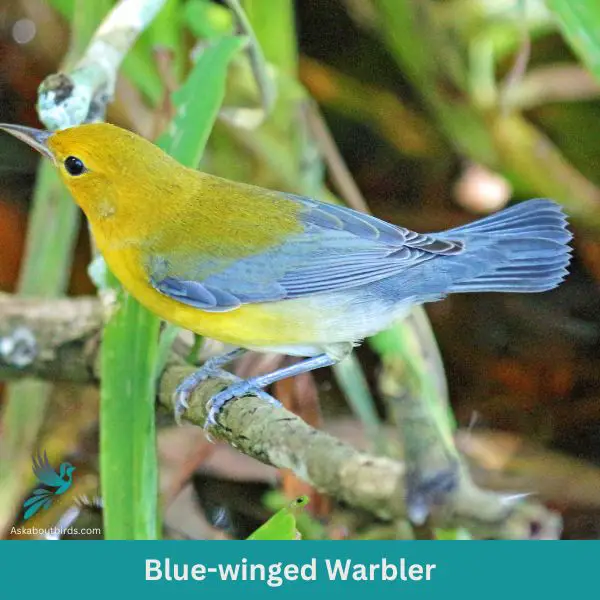
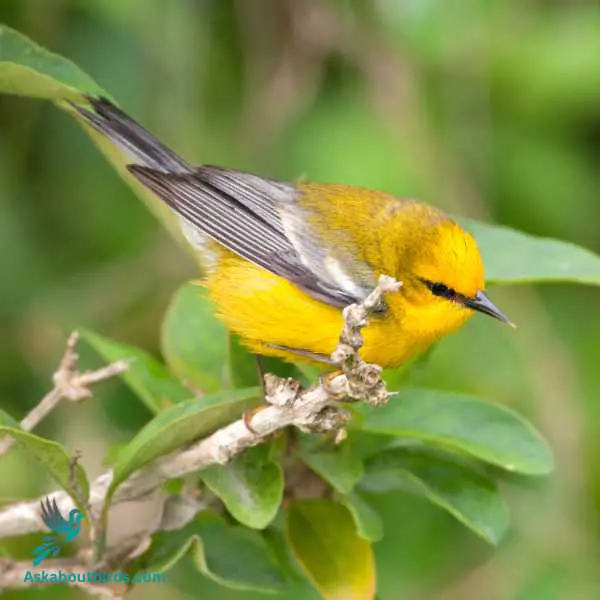
| Trait | Blue-winged Warbler |
|---|---|
| Scientific Name | Vermivora cyanoptera |
| Length | 4.3-4.7 inches |
| Wingspan | 6.7-7.5 inches |
| Weight | 0.3-0.4 ounces |
The Blue-winged Warbler is a vibrant songbird that stands out with its lemon-yellow coloring and buzzing song.
Appearance: This warbler displays a brilliant yellow body contrasted by blue-gray wings and a slim, black line through the eyes. The wings also feature two white wing bars.
Diet: The diet of the Blue-winged Warbler primarily consists of insects and spiders. They actively forage in shrubs and low trees, picking off their prey from the foliage.
Reproduction: Blue-winged Warblers build their nests on or near the ground, using grasses and other fine materials. The female lays a clutch of 4-6 eggs, which she incubates.
Blue Grosbeak
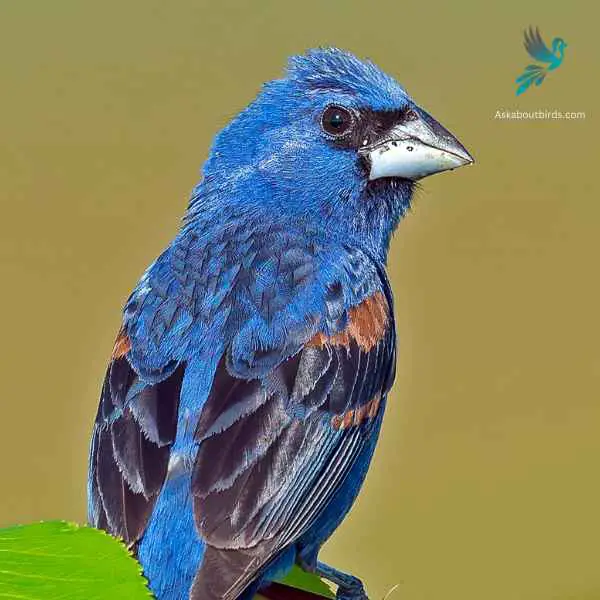
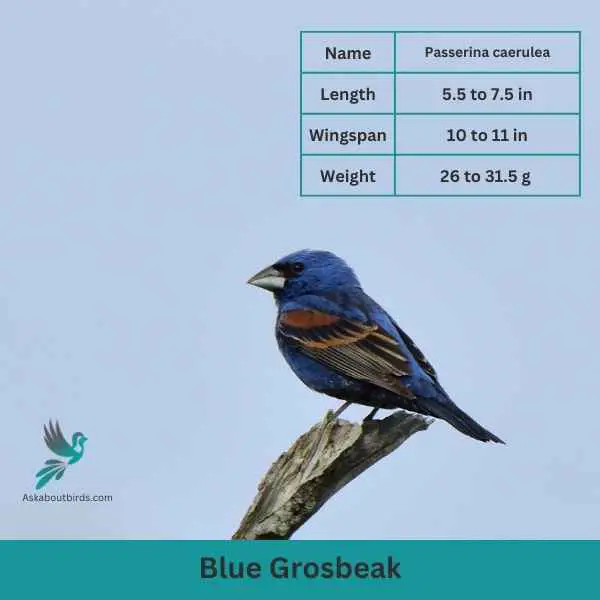
| Feature | Measurement |
|---|---|
| Scientific Name | Passerina caerulea |
| Length | 5.5 to 7.5 in |
| Wingspan | 10 to 11 in |
| Weight | 26 to 31.5 g |
The Blue Grosbeak is a medium-sized songbird found in North and Central America. The male Blue Grosbeak displays stunning plumage with deep blue feathers on its body and head, while the female has more subdued brownish tones. Both sexes have a thick, conical bill, which gives them their name “grosbeak,” meaning large beak.
These birds prefer open habitats such as grasslands, brushy areas, and woodland edges. Blue Grosbeaks are known for their melodious songs, which consist of a series of rich and varied notes. They primarily feed on seeds and insects, using their strong beaks to crack open seeds and forage on the ground or in low vegetation.
Cerulean Warbler
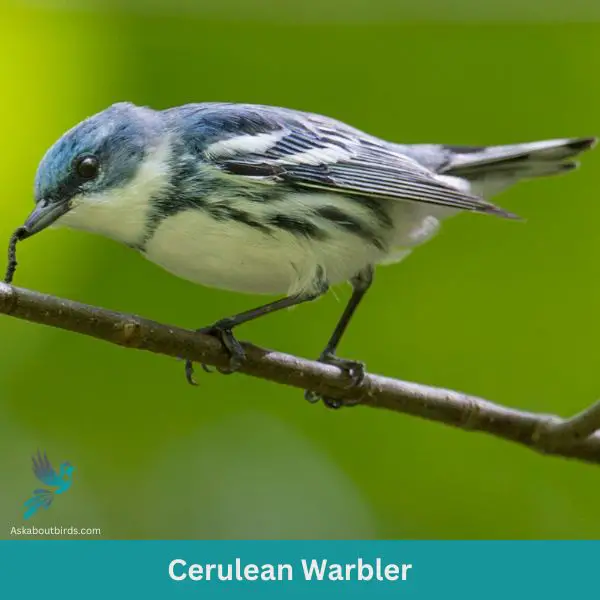
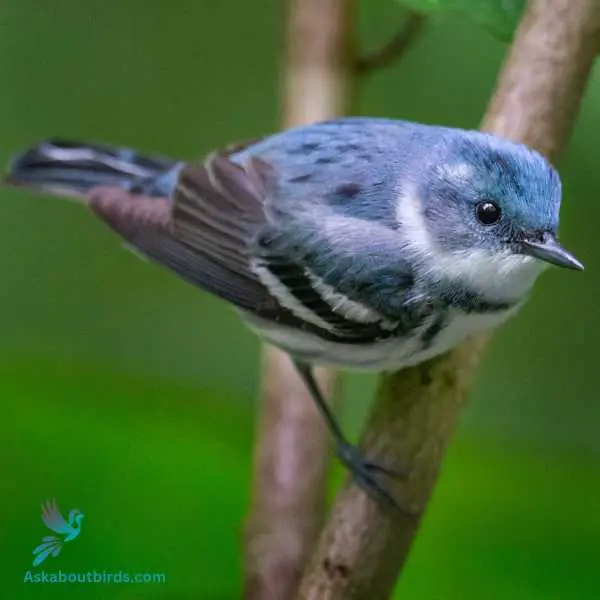
| Trait | Cerulean Warbler |
|---|---|
| Scientific Name | Setophaga cerulea |
| Length | 4.5 inches |
| Wingspan | 7.9-8.7 inches |
| Weight | 0.3-0.4 ounces |
The Cerulean Warbler is a striking songbird known for its sky-blue plumage and flitting movements in the forest canopy.
Appearance: Males boast a vibrant cerulean blue color on their upperparts, with streaked underparts, and a black necklace. Females have a more subdued bluish-green hue and lack the prominent black markings seen in males.
Diet: The diet of the Cerulean Warbler is predominantly made up of insects and spiders. They actively forage high in the treetops, gracefully maneuvering through leaves and branches.
Reproduction: Cerulean Warblers nest in the upper branches of tall deciduous trees. The female weaves a shallow cup-shaped nest and lays a clutch of 3-5 eggs.
Blue-headed Vireo
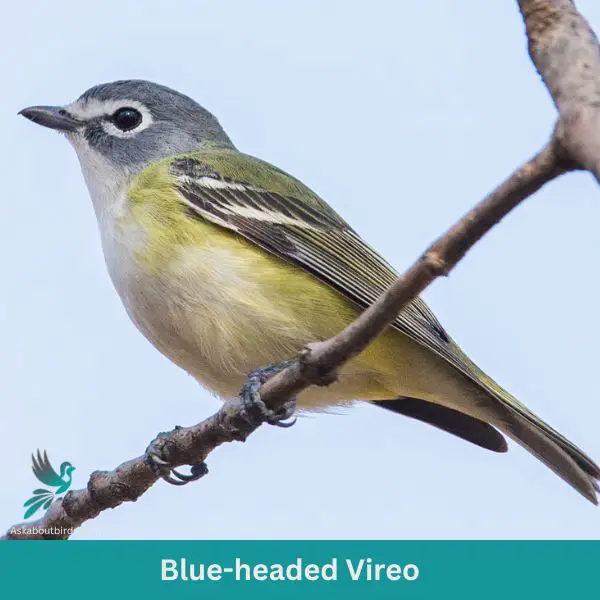
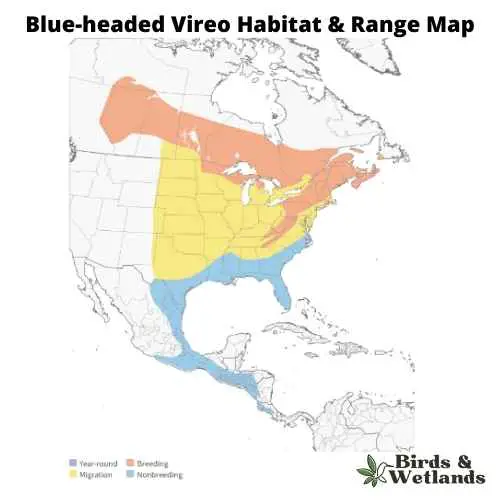
| Trait | Blue-headed Vireo |
|---|---|
| Scientific Name | Vireo solitarius |
| Length | 5-5.5 inches |
| Wingspan | 7.9-9.8 inches |
| Weight | 0.4-0.6 ounces |
The Blue-headed Vireo is a songbird recognized for its sharp and clear song as well as its distinct coloration.
Appearance: It has a blue-gray head and nape, contrasting sharply with its white throat and belly. A white eye ring combined with two white wing bars and yellowish flanks further accentuate its appearance.
Diet: The Blue-headed Vireo feeds mainly on insects and spiders. It often forages in the forest canopy, picking prey off leaves and twigs.
Reproduction: The female constructs a cup-shaped nest made of twigs, bark, and spiderwebs, often placed in the fork of a tree branch. Typically, she lays a clutch of 3-5 eggs. Both parents share the responsibility of incubating the eggs and feeding the chicks.
Where to Spot Delaware’s Blue Birds
The small yet diverse landscape of Delaware is a haven for birdwatchers, particularly those with an affinity for blue birds. From coastal plains to deciduous forests, here are the top 5 locations in the First State known for their great diversity of avian species:
- Bombay Hook National Wildlife Refuge: Located on the Delaware Bay, this 16,000-acre refuge is a hotspot for migratory birds and is home to a variety of habitats from tidal salt marshes to mixed hardwood forests.
- Prime Hook National Wildlife Refuge: Another important stopover for migratory birds along the Atlantic Flyway, this 10,000-acre refuge features freshwater marshes, ponds, and forests, attracting a wide variety of bird species.
- Cape Henlopen State Park: Located at the point where the Delaware Bay meets the Atlantic Ocean, this park offers a variety of habitats and is a great spot for observing shorebirds, raptors, and songbirds.
- Brandywine Creek State Park: This 933-acre park, located in the piedmont region, features mixed hardwood forests, meadows, and freshwater streams, making it an ideal location for spotting a diverse range of bird species.
- Delaware Seashore State Park: This park, located along the Atlantic coast, offers a variety of habitats from dunes to salt marshes and is a great location for spotting shorebirds and waterfowl.
| State’s Blue Birds | Top Spots for Blue Birds |
|---|---|
| Maryland’s Blue Birds | 1. Blackwater National Wildlife Refuge 2. Patapsco Valley State Park 3. Catoctin Mountain Park |
| New Jersey’s Blue Birds | 1. Cape May Point State Park 2. The Meadowlands 3. Great Swamp National Wildlife Refuge |
| Pennsylvania’s Blue Birds | 1. John Heinz National Wildlife Refuge 2. Hawk Mountain Sanctuary 3. Presque Isle State Park |
FAQs on Blue Bird Species Found in Delaware
What is the best location to place a bird feeder to attract blue colored birds?
The best location to place a bird feeder to attract blue colored birds like bluebirds and indigo buntings is in an open area with scattered trees. Bluebirds prefer open spaces with a few trees where they can perch and catch insects. Avoid heavily forested areas and try to place the bird feeder near a tree or shrub, which can provide a quick escape route for small birds if a predator approaches. Also, keep the bird feeder clean and regularly refill it with their favorite foods like sunflower seeds and live mealworms.
Where can I find Black-throated Blue Warblers?
Black-throated Blue Warblers are beautiful birds with a unique color pattern of blue, black, and white. They breed in the deciduous and mixed forests of the northeastern United States and the southern parts of Canada. According to the range map, during the winter season, they migrate to the Caribbean and parts of Central America, extending down into South America. They are mostly found in forested areas during both seasons.
What is the range of the Indigo Bunting?
The Indigo Bunting is a small bird with vibrant blue feathers that is found in North and South America. According to the Indigo Bunting range map, during the breeding season, they are commonly found in the eastern half of the United States, extending as far west as central Texas and Oklahoma. They prefer habitats with open spaces and scattered trees, like farmlands, roadsides, and golf courses. In winter, they migrate south to Central America, the Caribbean, and the northern parts of South America.
How can I attract Eastern bluebirds to my backyard?
To attract feeding bluebirds to your backyard, provide them with their favorite foods in a bird feeder, such as sunflower seeds, live mealworms, and small flocks of insects. Also, put up a bluebird house with a 1.5 inch entrance hole in an open space with scattered trees. Make sure to regularly clean the the bird feeders house and monitor for invasive species like house sparrows. Providing a source of fresh water, especially in winter, will also help attract feeding bluebirds back. Lastly, minimize the use of pesticides in your yard, as bluebirds mainly feed on insects.
